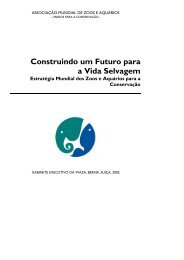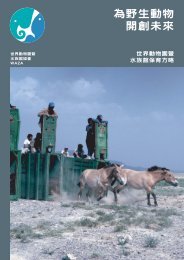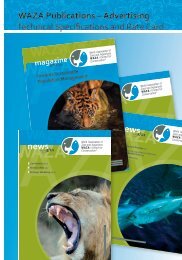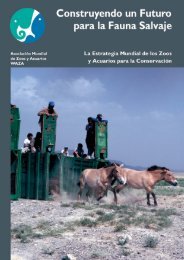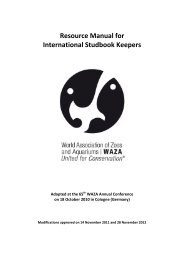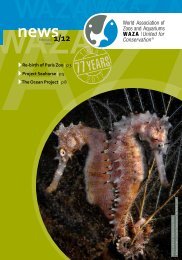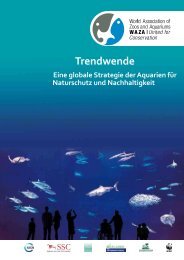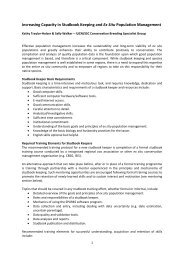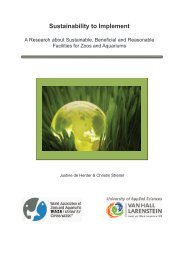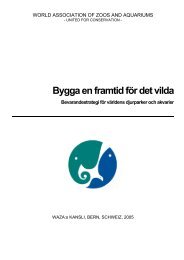Towards Sustainable Population Management - Waza
Towards Sustainable Population Management - Waza
Towards Sustainable Population Management - Waza
Create successful ePaper yourself
Turn your PDF publications into a flip-book with our unique Google optimized e-Paper software.
WAZA magazine Vol 12/2011<br />
Zoos hold only a small fraction of the<br />
world’s threatened species, maintain<br />
studbooks for only a portion of these<br />
and actively manage even fewer,<br />
often not effectively as sustainable<br />
populations. A database of species<br />
managed by the regional zoo associations<br />
was compiled to evaluate the<br />
scope of the situation, to assess the<br />
level of management across taxa and<br />
regions and to serve as a potential<br />
tool to identify gaps and opportunities<br />
for inter-regional management in<br />
existing zoo populations.<br />
Managed Species<br />
Database<br />
A database was developed comprised<br />
of 942 taxa monitored (via an active<br />
studbook) and/or actively managed<br />
by regional zoo associations or under<br />
the Amphibian Ark (AArk). Taxa were<br />
listed at the species level except in<br />
a few cases in which multiple regions<br />
manage by subspecies and/or the category<br />
of threat deviated by subspecies.<br />
Partula snails were considered as<br />
one taxon, although approximately<br />
20 species are managed. For each<br />
taxon, the 2010 IUCN Red List status<br />
of threat was recorded along with<br />
the presence of any monitored or<br />
managed population in each of ten<br />
regional zoo associations – AZA<br />
(North America), EAZA (Europe), ZAA<br />
(Australasia), JAZA (Japan), CAZG<br />
(China), SEAZA (South East Asia),<br />
CZA (India), PAAZAB (Africa), ALPZA<br />
(Latin America) and AMACZOOA<br />
(Mesoamerica) – as well as AArk, and<br />
the level of management, using the<br />
following definitions:<br />
• Monitored population: Regional or<br />
international studbook only; this<br />
category also includes ZAA MON1<br />
and MON2 programmes. No population-level<br />
management.<br />
Fig. 1<br />
Percentage of 4,733 IUCN-assessed threatened taxa that are held in ISIS member zoos (14.7%),<br />
have studbooks (8.9%), are managed (7.7%) and are intensively managed (5.4%).<br />
• Managed population: Some<br />
population-level management (e.g.<br />
studbook data analysis, general<br />
recommendations for breeding and/<br />
or transfers); this category includes<br />
AZA <strong>Population</strong> <strong>Management</strong> Plans<br />
(PMPs), EAZA European Studbooks<br />
(ESBs) and low-intensity management<br />
programmes identified by<br />
other regional associations.<br />
• Intensively managed population:<br />
Structured population-level management<br />
(e.g. species management<br />
committee, mandatory breeding<br />
and transfer plan); this category<br />
includes AZA Species Survival Plans<br />
(SSPs), EAZA European Endangered<br />
Species Programmes (EEPs),<br />
ZAA Conservation Programmes<br />
(CPs) and <strong>Population</strong> <strong>Management</strong><br />
Programmes (PMPs), AArk programmes<br />
and other high-intensity<br />
management programmes identified<br />
by other regional associations.<br />
Programme data were obtained either<br />
directly from the zoo associations,<br />
population managers working in the<br />
region and/or association websites,<br />
and are believed to be current as of<br />
early 2011. For analysis purposes, species<br />
listed as Extinct in the Wild were<br />
included among threatened taxa.<br />
Managed Programmes<br />
Managed Species<br />
Characteristics<br />
The majority of the 942 monitored<br />
taxa are mammals (44%) and birds<br />
(31%), with the rest divided among<br />
reptiles (10%), amphibians (7%),<br />
fishes (7%) and invertebrates (< 1%).<br />
Studbooks fall evenly between<br />
threatened (48%) and non-threatened<br />
(45%) taxa, with the remaining<br />
7% of undetermined threat status<br />
(Data Deficient or not assessed by<br />
IUCN). Comparison of this database<br />
with data reported by Conde<br />
et al. (2011) indicate that while 15%<br />
of threatened vertebrate species<br />
(excluding fish) are held in zoos, only<br />
about one-third of these (5.4%) are<br />
intensively managed by zoos (Fig. 1).<br />
31<br />
»



